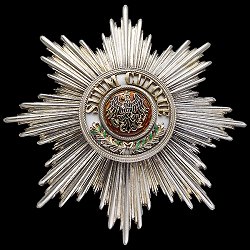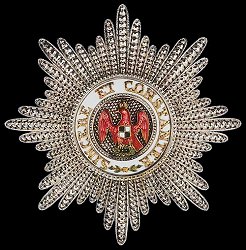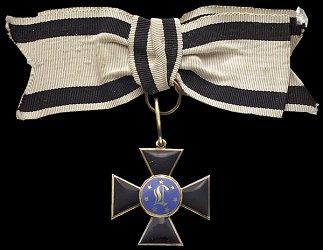H.I.&R.H. Prince Georg-Friedrich
Hohenzollern (Empire)
H.I.&R.H. Prince Georg-Friedrich
Grand Master of
Royal House Order of Hohenzollern - Established: 5 December 1841 by Prince Konstantin of Hohenzollern-Hechingen and Prince Karl Anton of Hohenzollern-Sigmaringen. These two principalities in southern Germany were Catholic collateral lines of the House of Hohenzollern, cousins to the Protestant ruling house of Prussia.
On August 23, 1851, after the two principalities had been annexed by Prussia, the order was adopted by the Prussian branch of the house. Also, although the two principalities had become an administrative region of the Prussian kingdom, the princely lines continued to award the order as a house order. The Prussian version was then known as the Royal House Order of Hohenzollern (Königlicher Hausorden von Hohenzollern or Königlich Hohenzollernscher Hausorden), to distinguish it from the Princely House Order of Hohenzollern (Fürstlicher Hausorden von Hohenzollern or Fürstlich Hohenzollernscher Hausorden). Although Kaiser Wilhelm II abdicated in 1918 as German Emperor and King of Prussia, he did not relinquish his role as Head of the Royal House and as such he was still able to confer the Royal House Order. The Princely House Order continued to be awarded after the fall of the German Monarchy as well, albeit also unofficially.
Another development occurred in 1935. Prince Karl Anton's second son, Karl Eitel Friedrich of Hohenzollern-Sigmaringen, had become prince and then king of Romania as Carol I. Carol I had died childless and was succeeded by his nephew Ferdinand I, also of Hohenzollern-Sigmaringen. During the reign of Ferdinand's son King Carol II, the Romanian government established its own version of the House Order of Hohenzollern, known in Romanian as Ordinul "Bene Merenti" al Casei Domnitoare ("Order of 'Bene Merenti' of the Ruling House"). This form of the order existed until the Romanian monarchy was abolished in 1947, and King Michael has awarded a slightly altered order in exile.
Order of the Black Eagle - Established: 17 January 1701 by Elector Friedrich III of Brandenburg (who became Friedrich I, King in Prussia, the following day). In his Dutch exile the Emperor Wilhelm II did continue to award the order on his family. He made his second wife, Princess Hermine Reuss of Greiz, a Lady in the Order of the Black Eagle.

Order of the Red Eagle - Established: 17 November 1705, by the Margrave Georg Wilhelm of Brandenburg-Bayreuth as the Ordre de la Sincerité. This soon fell into disuse but was revived in 1712 in Brandenburg-Bayreuth and again in 1734 in Brandenburg-Ansbach, where it first received the name "Order of the Brandenburg Red Eagle". The statutes were changed in 1777 and the Order named therein as the "Order of the Red Eagle". The Order was conferred in one class, limited to fifty knights.
The Kingdom of Prussia absorbed both Brandenburg-Bayreuth and Brandenburg-Ansbach in January, 1792, and on June 12, 1792, King Frederick William II again revived the order as a Prussian royal order. After the Order of the Black Eagle, the Red Eagle was the second highest order of the kingdom in order of precedence.
In 1810, King Frederick William III revised the statutes of the Order, expanding it into three classes. In 1830, a breast star was authorized for the Second Class and a Fourth Class was added to the Order. The statutes were further revised in 1861, and a Grand Cross was established as the highest class of the Order. By change to the statutes of the Order of the Black Eagle, every member of that order was automatically invested with the new Grand Cross of the Order of the Red Eagle, as well as with the Order of the Prussian Crown. By 1918, an affiliated soldier's medal had been made available to commoners and enlisted men.
The monarchy collapsed on November 9, 1918. Though Wilhelm II formally abdicated his personal claims to the throne on November 28, 1918, he admonished his former subjects to "render assistance to those in actual power" until the "re-establishment of order in the German Empire" (1923 Source Records of the Great War, Vol. VI, edited by Charles F. Horne). A new German constitution was signed into law, August 11, 1919, effectually putting a legal end to the monarchy. All orders and decorations formally conferred by the monarchy ceased to exist, but recipients of the Order of the Red Eagle continued to wear it with their other decorations during the eras of the Weimar Republic, the Third Reich, and the restored republic.

Order of Louise - Established: 1814 by King Friedrich Wilhelm III to honor his late wife, the much beloved Queen Luise (née Luise Auguste Wilhelmine Amalie, Herzogin zu Mecklenburg-Strelitz). This order was chivalric in nature, but was intended strictly for women whose service to Germany was worthy of such high national recognition. Its dame companion members were limited to 100 in number, and were intended to be drawn from all classes.
Though the Prussian king was technically the "Sovereign of the Orders" of the realm, the Chief of the Order of Louise was the reigning queen. Daughters in the royal family were invested with this order in lieu of the Order of the Black Eagle, Order of the Red Eagle Grand Cross, Prussian Crown Order First Class, and Royal House Order of Hohenzollern that were reserved for the sons.
The Order of Louise was renewed with each successive king or emperor. It was, thus, issued from its founding in 1814 (during the reign of Friedrich Wilhelm III), renewed in 1850 (during the reign of Friedrich Wilhelm IV), in 1865 (during the reign of Wilhelm I), and in 1890 (during the reign of Wilhelm II).
